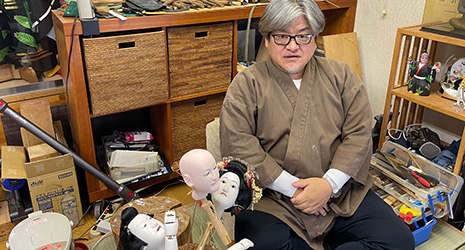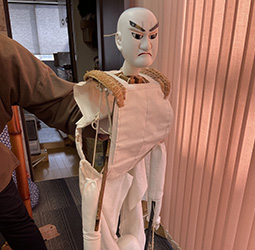March 2022
- English
- 日本語
Ningyo Joruri Puppets

Bunraku puppet craftsman Hishida Masayuki in his workshop

Female puppet, Tamategozen 
Female puppet, Osono 
Male puppet, Sanbaso 
The anatomy of a male puppet

Ningyo joruri is a notable traditional Japanese performing art that involves the skillful manipulation of puppets to perform stories. The puppets are crafted with passion by puppet craftsmen.

With a history of about 400 years, ningyo joruri is one of Japan’s leading traditional performing arts. It is musical drama where puppets are skillfully manipulated to express the human emotions alongside joruri*. The themes of the dramas are diverse, covering events or stories related to court nobles or samurai to incidents or stories from the everyday lives of ordinary people.
Ningyo joruri has been passed down through the generations in various regions of Japan. Ningyo joruri bunraku, or bunraku, was established in Osaka and is a representative example still today. In 2008, Bunraku was registered by UNESCO as Intangible Cultural Heritage of Humanity along with Nogaku and Kabuki.
Bunraku and other ningyo joruri puppets are about 130 to 150 centimeters long and weigh several kilograms, with some weighing more than 10 kilograms. Known as “three-person puppeteering” (sannin-zukai), there are usually three puppeteers controlling a single puppet. Each puppeteer has a specific role: the “lead puppeteer” (omo-zukai) moves the puppet’s head and right hand, the “left-hand puppeteer” (hidari-zukai) moves the left hand, and the “foot puppeteer” (ashi-zukai) moves the feet. Following the signals of the lead puppeteer, the three people work as one as they make the puppet move and express various human emotions, such as laughter and tears.

Hishida Masayuki, bunraku puppet craftsman and representative director of the puppet atelier Gasha in Higashiosaka City, Osaka Prefecture, explains, “When ningyo joruri first appeared, it was ‘one-person puppeteering’ (hitori-zukai) where one person controls one puppet. However, as the depiction of characters’ movements became more elaborate, improvements were made to how the puppets could move, including eyebrows moving up and down, giving sidelong glances, having sleepy eyes, and opening and closing the mouth. It seems that something like the current bunraku ‘three-person puppeteering’ was standard by the end of the eighteenth century at the latest.”
Bunraku and other ningyo joruri puppets are composed of the head part called “kashira” and the body part called “do.” The puppet heads are hand-carved from Japanese cypress and hollowed out inside to fit all the devices needed to move the eyes, eyebrows, mouth, and so forth. The puppeteer pulls and loosens the threads connected to the head to move the puppet’s eyes, eyebrows, mouth, and head up and down. By changing the angle of the head, the puppeteers can express various human emotions. These threads are the most important device on the stage. Thick and strong silk threads are used to prevent them from breaking on stage.

The puppet’s body is simply constructed as a wooden oval “shoulder board” (kataita) and a bamboo circular “hip ring” (koshiwa) joined together with cloth and strings. The puppet’s “hands” and “feet” are connected to the shoulder board with string, but female puppets lack feet, so the puppeteer moves the hem of the kimono to create the illusion of feet.
Hishida comments, “Bunraku and other ningyo joruri puppets today adopt costumes and hairstyles to suit the time period in which the story is set and we faithfully tailor them to depict the life and culture of people of the time.”

Unlike hina dolls and other dolls that are put on display to be seen and enjoyed, ningyo joruri puppets come alive only when they are moved, which is why Hishida says that he only makes them after first having a very clear idea of how they will look “when moving.” Hishida explains that he envisions a scene in which each puppet plays their role on the stage as he imbues each puppet he makes with “character.” Hishida is passionate about carving puppets with “character” that accurately express the characteristics of different roles according to the story, in the same way that skilled actors change their performance and figure according to the role.
When the puppeteers skillfully move puppets imbued with this “character,” they convey the human emotions and it becomes ningyo joruri that moves an audience.
Ningyo joruri, which has been moving emotions for hundreds of years, has been passed down to the present day thanks to the skills of puppet craftsmen like Hishida, finally allowing it to be recognized as a traditional performing art on the global stage.
* The collective name for katarimono (narratives) accompanied by the shamisen three-string lute. “Katarimono” traditionally referred to “stories told with a beat rhythm from the shamisen.” Nowadays, it often means Gidayu-bushi, a form of joruri.

